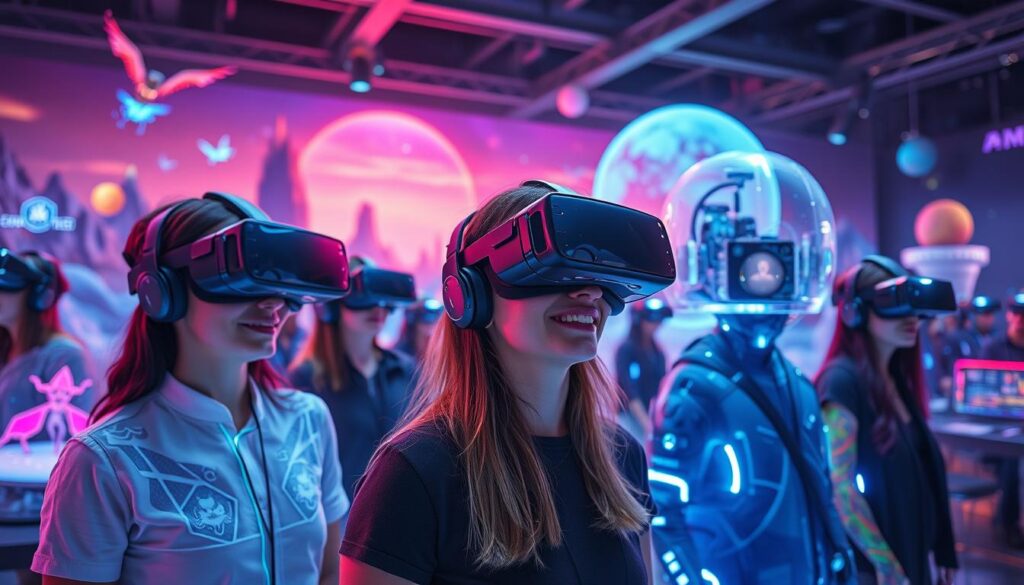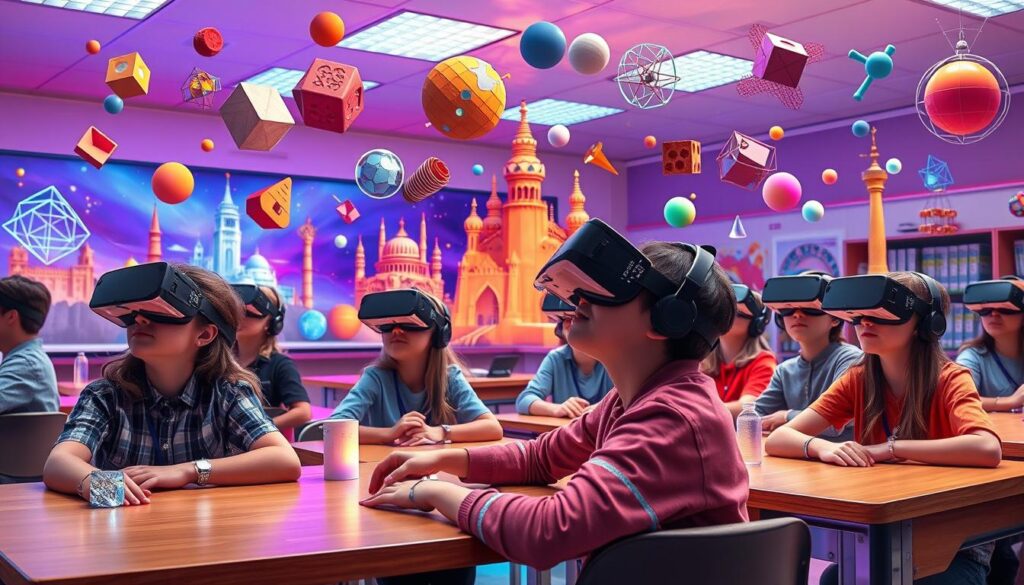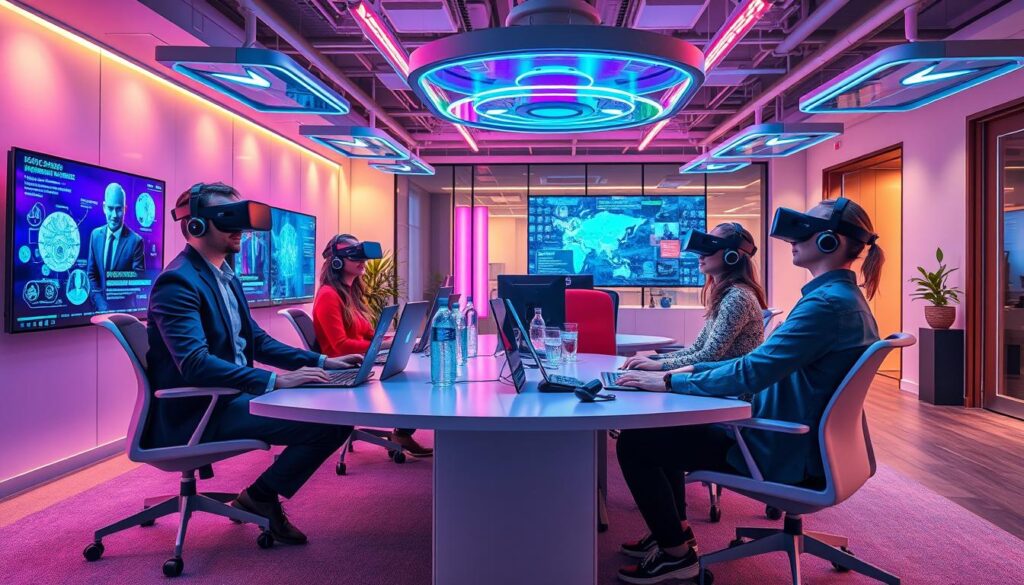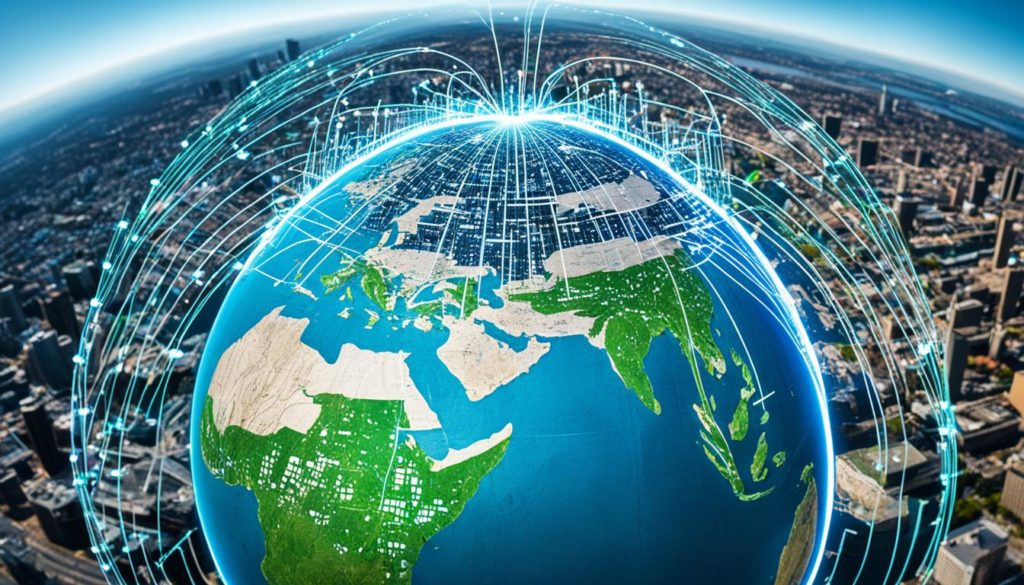
Did you know the global VR market is expected to grow by 22.9% each year? It could reach over $187 billion by 2032. This shows VR is no longer just for a few; it’s becoming mainstream. In 2024, expect big changes in VR, with new headsets and tracking systems.
Whether you love VR or use it for work, 2024 will bring exciting updates. We’ll explore how VR is changing the world. It’s not just for fun anymore; it’s also changing how we work.
VR is getting better, making it easier to use every day. The pandemic has also made VR more popular in business. Now, teams can work together from anywhere.
Imagine thousands of people joining live events in VR. Or picture VR that feels like part of the real world. These ideas are becoming real. VR is changing the world in big ways.
Key Takeaways
- The global VR market is expected to grow at a CAGR of 22.9%, potentially surpassing $187 billion by 2032.
- Standalone VR headsets are anticipated to dominate the market in 2024.
- The COVID-19 pandemic has accelerated the adoption of VR in business settings, enhancing collaboration and productivity.
- Innovations like VR passthrough technology are set to revolutionize user experiences by blending virtual and physical environments.
- VR technologies are not only captivating casual users but are also transforming professional environments.
The Evolution of VR Technologies
The journey of virtual reality (VR) technologies has been truly remarkable. It started in the 19th century and has seen rapid growth in recent years. Today, VR is a major player in many fields, including entertainment, education, and healthcare.
From Concept to Reality: A Brief History
In 1838, Sir Charles Wheatstone introduced the stereoscope, showing how our brains can turn 2D images into 3D. The 1930s brought Stanley G. Weinbaum’s idea of goggles for immersive experiences. By 1962, Morton Heilig had created Sensorama, the first VR machine with 3D video, sound, and smells.
In the 1980s, Myron Krueger’s VIDEOPLACE was the first interactive VR platform. It allowed users to see their computer-generated silhouettes in action. This was a big step towards the VR we know today.
Milestones in VR Development
VR technologies have seen many important milestones:
- 1838: Charles Wheatstone’s stereoscope showed immersive viewing.
- 1962: Morton Heilig’s Sensorama offered the first full-color 3D video experience.
- 1975: Myron Krueger’s VIDEOPLACE created interactive VR environments.
- 1995: Nintendo’s Virtual Boy brought VR gaming to the consumer market.
- 2012: The Oculus prototype by Palmer Luckey changed how we see VR.
Key Players in the VR Market
Today, several companies are leading the VR market. Facebook’s acquisition of Oculus in 2014 was a big moment. It helped make high-quality VR headsets available.
Oculus and HTC Vive are now known for their VR innovations. Samsung VR and Sony’s PlayStation VR have also made VR more accessible. These companies have changed how we use VR, making it more than just gaming.
They use advanced VR tools to create new experiences. These experiences are used in education, training, and more. They keep pushing the limits of what VR can do.
VR Technology Applications Beyond Gaming
VR technology has grown a lot in recent years. It’s now used in education, healthcare, and industry. These areas use VR to create new solutions.
Education and Training

VR is also helping students with special needs and language learning. It offers a chance to immerse in different cultures. This shows VR’s huge potential in education.
Thanks to 3D modeling and CAD technologies, VR tools are now more accessible. Even smartphones and headsets can use them. This makes learning more inclusive and effective for everyone.
Healthcare and Medical Simulations
VR is a key tool in healthcare for training and treatment. It’s used in programs like Advanced Cardiac Life Support (ACLS) simulations. These simulations give doctors a safe place to practice.
VR also helps in surgery training and mental health therapy. It’s used in Virtual Reality Exposure Therapy (VRET) for conditions like PTSD. This shows VR’s growing role in healthcare.
VR in Industrial and Engineering Sectors
VR is changing how tasks are done and training is given in industries like manufacturing and automotive. In the automotive field, VR is used for prototyping and safety training. It also helps in manufacturing and architecture.
A Harvard Business Review report says 87% of companies use VR for training. It helps standardize learning, improve efficiency, and reduce accidents. VR lets workers practice in safe environments, making them better prepared.
VR is a powerful tool for improving experiences and productivity in many industries. For more information, check out our detailed overview here.
Advancements in VR Hardware
The world of virtual reality hardware has seen huge changes. It has moved from old, heavy setups to today’s slim, strong devices. Let’s look at the latest updates that are changing VR’s future.
Standalone VR Devices: The New Standard
Standalone VR devices have changed the game. They don’t need a PC or console to work. This makes exploring virtual worlds easier. The VIVE XR Elite shows how far we’ve come.
It has built-in power and high-quality displays. This lets users dive into immersive worlds without extra gear.
Enhanced Tracking Technologies
VR tracking systems have improved a lot. They track your movements accurately, making the virtual world feel real. This reduces sickness and boosts the experience.
Today’s systems use sensors and cameras for smooth tracking. This makes moving around in VR feel natural.
Innovations in Display and Processing Power
Display and processing power have also improved a lot. High-resolution screens and fast processors make graphics look real. This is key for gaming and other uses.
Thanks to these updates, VR is more detailed and realistic. This is thanks to ongoing tech improvements.
With new VR hardware like the VIVE XR Elite and better tracking, VR’s future is exciting. These updates make VR more immersive and could make it part of our daily lives. For more on VR’s history and future, check out this article.
Immersive VR Experiences
Immersive virtual reality experiences are at the top of modern VR tech. They grab users with full-sensory environments. These experiences mix virtual and real worlds, opening new doors in entertainment and education.
Oculus started with a $2.4 million Kickstarter and was bought by Facebook for $2 billion in 2014. Since then, VR has grown a lot. Games like Beat Saber sold 1 million copies in just nine months, showing VR’s power.
VR systems work all of your senses, making things feel very real. Google Expeditions give students virtual field trips. Solera’s Intelligent Repair Estimator uses 3D car models for insurance.
5G tech is set to change VR even more, making it as common as phones by 2025. Despite ups and downs, the VR market was worth $33.2 billion in 2023. It’s expected to hit $228 billion by 2032.
But VR isn’t perfect. Big headsets and tech issues can ruin the experience. Also, there’s not enough content and making VR is expensive. Yet, fields like aviation, healthcare, and the military see VR’s value for training.
VR uses strong GPUs and precise tracking for smooth experiences. Haptic feedback makes it feel like you’re really there. Architects and designers use VR for virtual tours, improving design feedback.
| Statistic | Detail |
|---|---|
| Oculus Kickstarter Funding | $2.4 million |
| Acquisition by Facebook | $2 billion |
| Pokémon GO Downloads by 2016 | 500 million |
| Beat Saber Sales in Nine Months | 1 million copies |
| Immersive Tech Market Value (2023) | $33.2 billion |
| Projected Market Value (2032) | $228 billion |
| Peak Investment Year | 2017 |
Augmented Reality and Mixed Reality Innovations
AR and MR technologies are growing fast. Their differences, uses, and future are clearer. Each new step changes how we see digital and real worlds.
Differences Between AR, VR, and MR
It’s key to know the AR and VR differences. AR adds digital stuff to the real world, like on phones or smart glasses. MR mixes real and virtual, like with Microsoft HoloLens.
AR mainly makes the real world better. MR lets you play with real and virtual things together.
Applications of AR and MR in Real Life
AR and MR are used in many areas. They make things better and more fun. For example, Pokémon GO is a hit in gaming.
In education, apps make history come alive. MR is changing healthcare and construction too. It makes training and work better.
Future Prospects and Emerging Trends
The future of AR and MR looks bright. MR is getting into everyday items, like smart glasses. New tech, like Arm’s graphics, makes XR better.
But, there are still problems like battery life and privacy. Yet, work is being done to fix these. AR and MR will change many fields, making things more interactive and fun.
The Business Impact of VR Technologies
Virtual Reality (VR) has changed many parts of business. The VR market is growing fast, expected to hit $22 billion by 2025. It’s changing how we work remotely, train, and interact with customers.
Transforming Remote Work and Collaboration
VR is making remote work better. It creates virtual spaces where people can work together as if they were in the same room. Over 60% of workers want to use VR at work, showing it’s in demand.
This technology helps teams work better together. It makes work more productive and improves team spirit.
VR in Training and Development
VR is key in many fields, like healthcare and retail. Big names like Bank of America and NASA use it for training. Tulsa Welding School uses VR for their training, making learning more real.
Lowe’s saw a 36% better recall rate with VR. This shows VR can be a cost-effective and effective way to train.
Customer Engagement and Virtual Sales
VR changes how we engage with customers. It lets businesses show products in a new way. For example, it’s used in car sales to let customers see features in a virtual car.
VR also changes advertising. It lets companies create immersive experiences. This can make customers remember products and brands better.
VR is key for business growth. As VR learning grows, so does its role in business. For more on VR, check out this comprehensive literature review.
| Statistic | Description |
|---|---|
| $12 billion | Global VR market value in 2022 |
| $22 billion | Projected global VR market value by 2025 |
| 50% | Expected growth in the VR market |
| 60% | Employees eager for VR integration in offices |
| 36% | Better recall rate using VR for customer training |
Conclusion
As we look ahead to 2024, the future of VR is very exciting. VR technology is now used in many areas, changing how we interact online. We see better displays, advanced tracking, and affordable headsets like Oculus Go and Google Daydream.
This growth shows the huge potential of VR technology. It’s becoming more popular than ever.
In schools, VR is making learning fun and real. It takes students to places they’ve never seen before. This makes learning more interesting and helps them remember better.
A study by PwC found that VR-trained workers felt more connected to what they learned. This shows how powerful VR can be in education and training.
VR also helps in healthcare by easing anxiety and PTSD symptoms. It creates safe spaces for therapy. The gaming world is also getting a boost from VR, offering deeper and more engaging experiences.
This shows how VR is changing our lives and work. It’s making our experiences and jobs better in many ways.
FAQ
What are the current trends in VR technologies?
VR tech is advancing fast. We see better standalone headsets and tracking systems. People want more immersive experiences. The VR market is expected to hit 7 billion by 2032.
Can you provide a brief history of VR development?
VR started in the 1960s with devices like the Telesphere Mask. The Oculus prototype in 2012 was a big step. Facebook’s buy of Oculus helped VR become more popular.
Who are the key players in the VR market?
Oculus (now Meta), HTC Vive, and Samsung VR lead the VR market. They drive innovation and shape VR’s future.
How is VR used in education and training?
VR changes education and training. It offers immersive, customizable simulations. This makes learning more effective and safe.
What are the benefits of VR in healthcare and medical simulations?
VR helps in healthcare by providing safe, real-like simulations. It helps doctors practice without risks.
How does VR optimize tasks in industrial and engineering sectors?
VR makes it safe to practice risky tasks. It helps companies improve processes and safety.
What advancements have been made in standalone VR devices?
Devices like the VIVE XR Elite are now more convenient and powerful. They make VR easy to use without extra gear.
How have tracking technologies improved in VR?
Tracking tech has gotten better. This means VR experiences are more precise and immersive.
What innovations are being made in VR display and processing power?
New displays and processing power make VR visuals sharper and smoother. This makes virtual worlds more realistic.
What makes immersive VR experiences so appealing?
Immersive VR offers 360-degree worlds that feel real. They’re engaging for many uses, from fun to learning.
What’s the difference between AR, VR, and MR?
AR adds digital stuff to real life. VR creates full virtual worlds. MR mixes both, blending virtual and real seamlessly.
How are AR and MR being applied in real life?
AR and MR are used in many ways. For example, in retail for try-ons, in healthcare for better diagnostics, and in education for interactive learning.
What future trends can we expect in AR and MR technologies?
We’ll see better device integration and user experiences. AR and MR will be used in more areas, like retail and education.
How is VR transforming remote work and collaboration?
VR is changing remote work. It creates virtual meeting spaces for better interactions. This boosts team productivity and presence.
What are the advantages of VR in training and development within businesses?
VR offers simulation-based training. It’s cost-effective and interactive. It often beats traditional methods by providing real practice.
How does VR enhance customer engagement and virtual sales?
VR creates engaging experiences. It lets customers see and interact with products virtually. This improves the sales process.
Future App Studios is an award-winning software development & outsourcing company. Our team of experts is ready to craft the solution your company needs.








